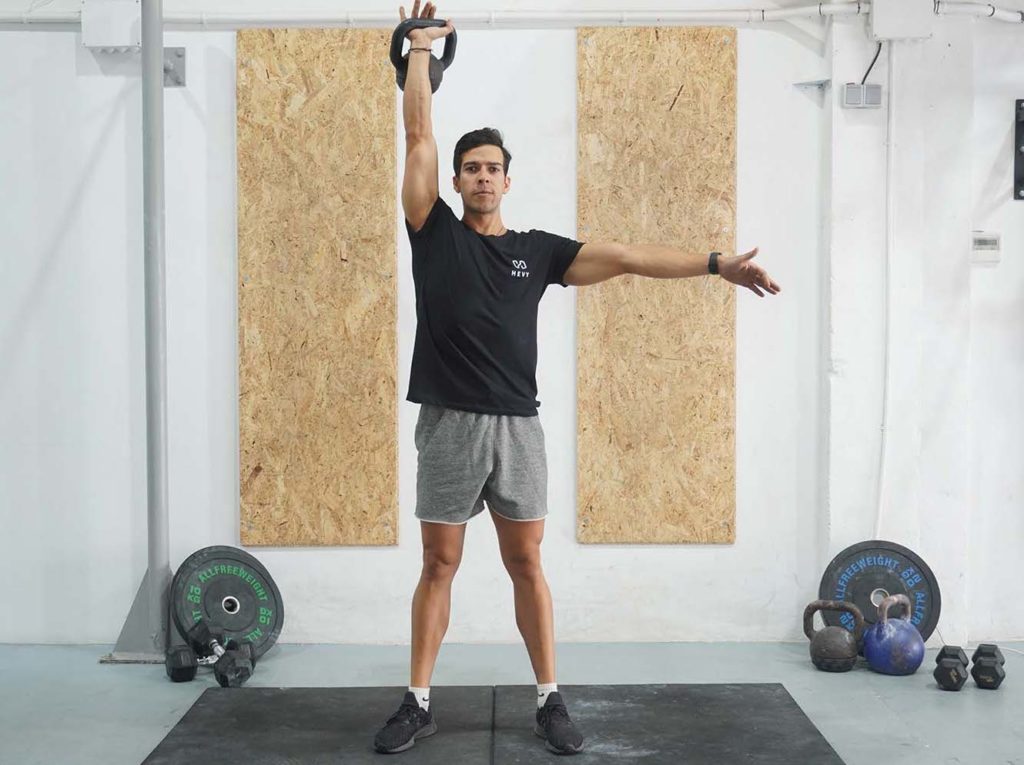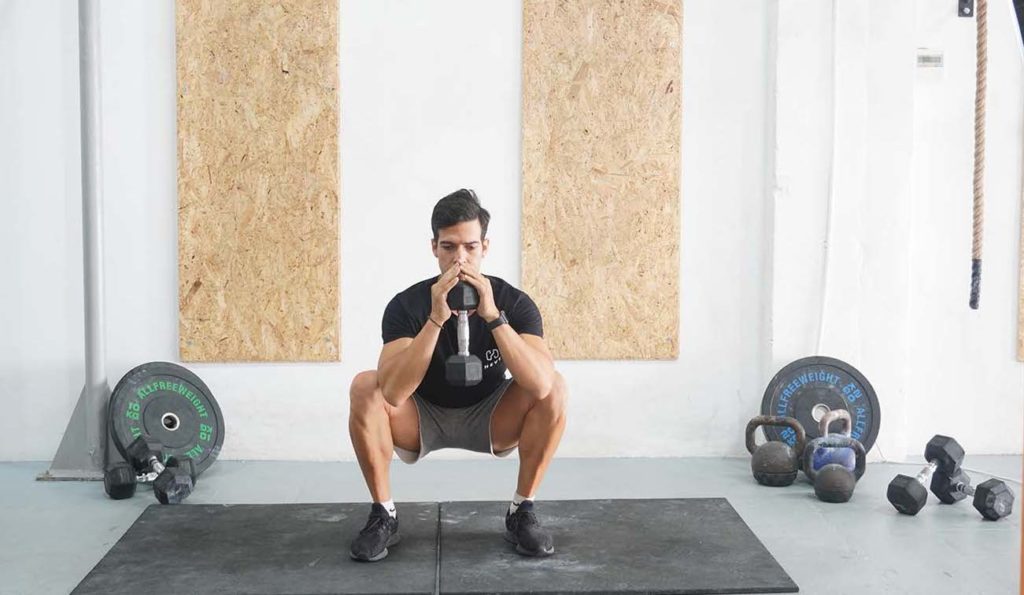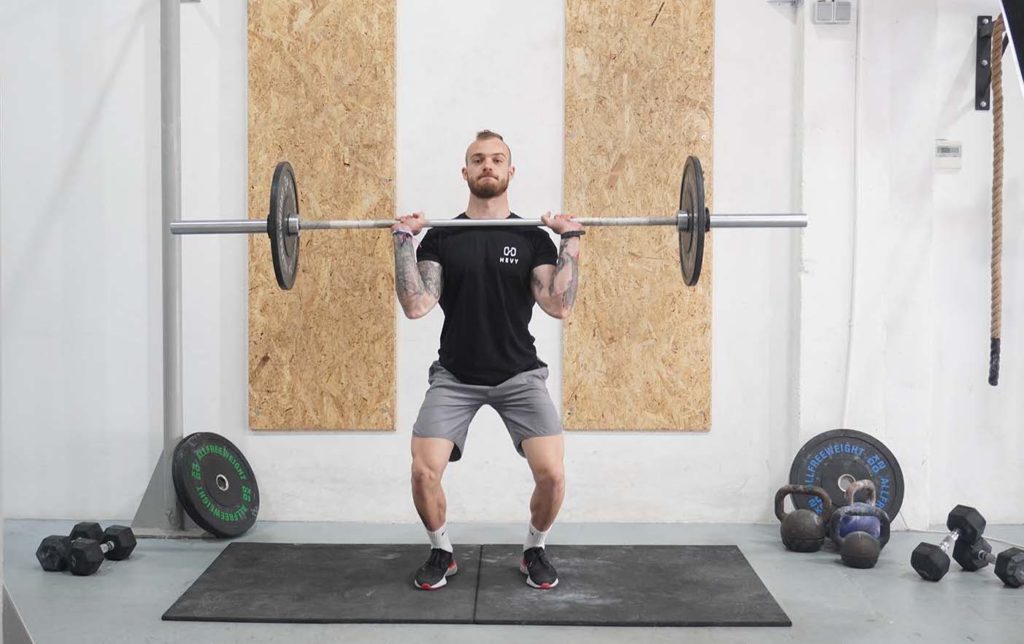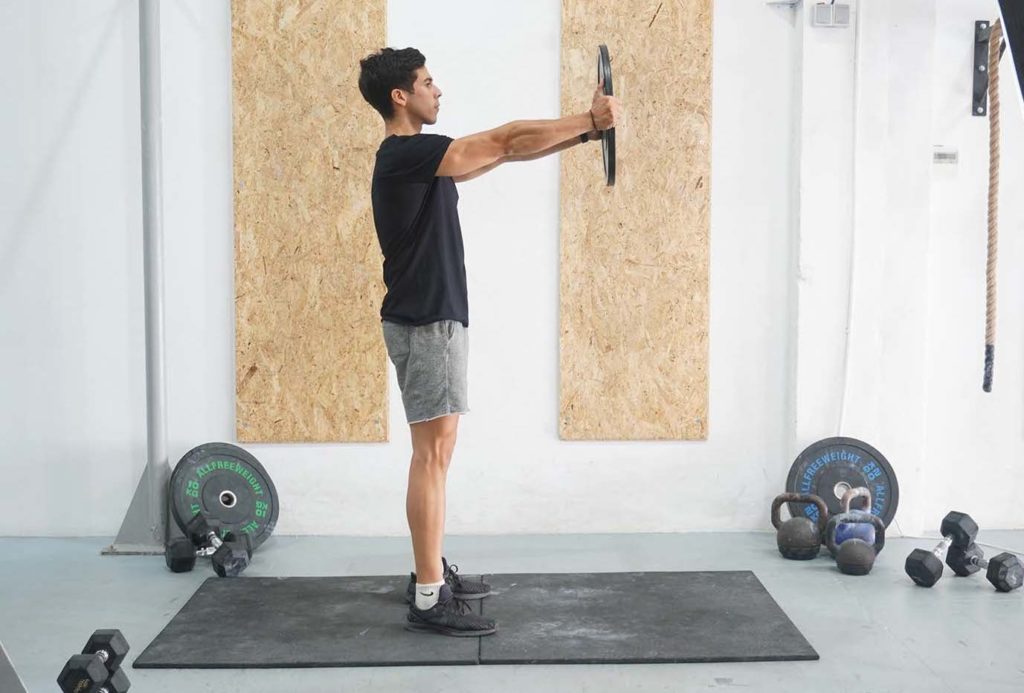The Benefits of the Kettlebell Thruster
The kettlebell thruster is one of the best full-body kettlebell exercises that burns a ton of calories and develops your athleticism, making everyday tasks more accessible.
A notable benefit of the exercise is that it develops multiple muscles in the lower body: the quadriceps, hamstrings, and glutes. The dumbbell thruster also involves the shoulders, triceps, upper chest, back, and midsection, making for an effective full-body workout. Plus, you can burn many calories and train your cardiovascular system, improving your endurance and recoverability.
We recommend including the single-arm kettlebell thruster (and most other kettlebell exercises) near the middle of a workout. For example, you can do two or three compound exercises and move to the kettlebell thruster. Perform multiple sets of at least 8 to 10 reps per arm.
Level of the kettlebell exercise: Intermediate
How to do a Single-Arm Kettlebell Thruster
- Grab a kettlebell, stand tall, and lift the weight to shoulder level. Keep your elbow bent and the kettlebell on the outer side, resting against your forearm and bicep (rack position).
- Have your feet at a hip-width distance with your toes pointing slightly out.
- Keep your free arm to the side and slightly out for balance.
- Bring your shoulders back, engage your abs, take a breath, and squat.
- Descend until your thighs are parallel to the floor and move up, pushing through your heels.
- As you reach the top of the squat, continue the movement by pressing the kettlebell over your head, extending your elbow fully. Exhale near the top.
- Lower the kettlebell to the side of your shoulder and into the starting position as you take another breath and descend for the next repetition.
- Once finished on one side, grab the kettlebell with your other hand and perform the same number of reps.
What muscles does the kettlebell thruster activate?
One of the primary muscle groups that work during a single-arm thruster is the quadriceps, which cover the front side of our thighs and produce knee extension (1). Our quadriceps control us as we descend into the squatting part and contract to extend our knees off the bottom position.
The hamstrings and glutes also play a role in the squat portion of the thruster since their primary job is to provide stability and extend our hips as we move up (2, 3).
Our deltoids are the second major muscle group active in a kettlebell thruster. These muscles activate and allow us to press the weight overhead (4). The triceps assist the deltoids because their primary function is elbow extension (5). Similarly, the upper chest (clavicular head) contributes by supporting our shoulders and triceps.
The back and midsection musculature provide torso support and help us remain stable as we descend and press the kettlebell overhead.
Tips on Proper Form when Performing the Kettlebell Thruster

While relatively straightforward, the kettlebell thruster can be challenging, and there is a small risk of injury if you’re not careful. Pick a lighter weight to learn the movement and always listen to your body for signs of pain or discomfort.
A vital tip to keep in mind for kettlebell thrusters is to transition from a squat to an overhead press in one fluid motion. Press the kettlebell up just as you have your knees fully extended. Then, descend just as you lower the kettlebell to the side of your shoulder and into the starting position.
Another tip to keep in mind for the kettlebell exercise is to squat until your thighs are at least parallel to the floor. Doing so is vital for proper quadriceps activation and growth. You should also press through your heels from the bottom position and avoid shifting your weight to your toes.
The third tip to keep in mind for the movement is maintaining whole-body tightness as you press the weight overhead. Squeeze your glutes and engage your abs as you finish the squat and transition into the press. Your body should be straight, and the kettlebell should be over the center of gravity.
Variations and Modifications of the Kettlebell Thruster
1. Double Kettlebell Thruster

The double kettlebell thruster is a more advanced version of the exercise that trains both sides of your upper body together. Instead of using a single weight, you have to hold a pair of kettlebells, squat, and extend your arms simultaneously.
2. Two-Arm Goblet Kettlebell Thruster
Similar to the double kettlebell thruster, the two-arm goblet variation trains both sides of your upper body together. But, instead of using two kettlebells, you’re holding one with both hands.
3. Single Kettlebell Clean to Thruster
The single kettlebell clean to thruster is a slightly more complex and advanced version of the classic exercise. With it, the objective is to squat, press the kettlebell, bring it down to your hip level, perform a swing, clean the weight back to shoulder level, and proceed with another squat and press.
Mistakes to Avoid
Using Heavy Kettlebells
A relatively common mistake with kettlebells is using too much weight. Most trainees pick a load they can squat without paying attention if they can press the kettlebell overhead. Avoid the error by selecting a kettlebell that feels light enough to squat but heavy enough to pose a challenge as you press overhead.
Not Squatting Low Enough
Another mistake with kettlebell thrusters is not squatting low enough. Doing so might allow you to do extra reps, but it will make each repetition less effective for your lower body. Fix the mistake by squatting until your thighs are parallel to the floor.
Pressing Kettlebells Outside Your Center of Gravity
The third error with kettlebell thrusters is pressing the weight slightly forward as it goes above your head. Most beginners would never notice making the mistake but doing so makes the exercise increasingly difficult. Pushing the weight in front of your center of gravity makes it more challenging to keep your balance. Avoid the error by pressing straight up having the kettlebell above your head.
Similar Exercises to the Kettlebell Thruster
Goblet Squat

Goblet squats are an effective accessory exercise for the quadriceps (6). The objective is to hold a dumbbell in front of your chest as you squat, and doing so forces you to maintain a more upright torso and train your upper back. The goblet squat isn’t the same as a kettlebell thruster, but it resembles the squats portion of the exercise.
Push Press

Push presses are a full-body exercise that strengthens a range of muscle groups, including your midsection, back, chest, shoulders, and triceps. The objective is to dip slightly by bending your knees and thrust the weight above your head. Push presses resemble the final part of a single kettlebell thruster because you have to generate momentum to transition into an overhead press.
Plate Front Raise

Plate front raises are different from kettlebell thruster, but performing them can improve your performance. The plate front raise is an excellent isolation exercise you can do to strengthen your shoulders, which would enhance your overhead pressing strength.

